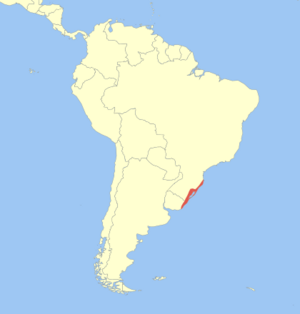Greater guinea pig facts for kids
Quick facts for kids Greater guinea pig |
|
|---|---|
 |
|
| Conservation status | |
| Scientific classification | |
 |
The greater guinea pig (Cavia magna) is a type of rodent that lives in the coastal areas of Brazil and Uruguay. You can find them in wet grasslands and marshy places.
Contents
About the Greater Guinea Pig
The greater guinea pig is a large rodent. Males can grow up to about 310 mm (12.2 in) long. They can weigh around 636 g (22.4 oz). Females are a bit smaller. They grow to about 303 mm (11.9 in) long. Females weigh around 537 g (18.9 oz).
Their fur on their back is a dark brown color. Their belly fur is reddish brown. These guinea pigs are good in water. They have special membranes between their toes. This helps them swim and move in wet areas.
Where They Live
This animal is found along the coast of eastern Uruguay. It also lives in southeastern Brazil. Their favorite places are moist grasslands and marshes. They also like the edges of woodlands and small valleys.
Life and Habits
The greater guinea pig is a plant-eater, also known as an herbivore. It lives by itself and builds many tunnels. These tunnels and paths go through the plants where it lives. The size of its home area can change. It depends on the animal's size, if it's a male or female, and how much water is in the area.
Reproduction
Female greater guinea pigs can have babies at any time of the year. However, most births happen in spring and early summer. A female can have up to three groups of babies in one year. Pregnancy lasts about 64 days. They usually have only one or two babies at a time.
The young are quite big when they are born. They also grow very quickly. Some young females born in the spring can have their own babies when they are only 30 to 45 days old.
Conservation Status
The International Union for Conservation of Nature (IUCN) checks on animals. They have listed the greater guinea pig as "least concern". This means it is not currently in danger of disappearing.
It lives in a specific area, but this area is quite large. It covers more than 20,000 square kilometres (7,722 sq mi). Experts believe there are many greater guinea pigs in total. Even though their numbers might be going down a little in Uruguay, it's not a big drop. This is why it's not considered a threatened species.


